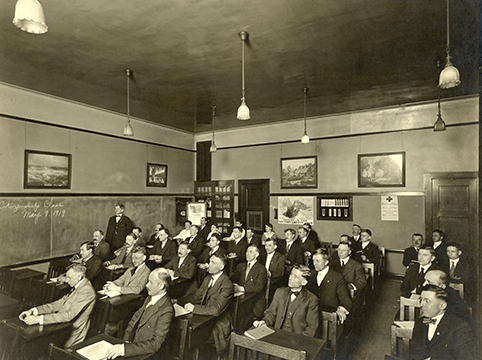Origins of the Naturalization Civics Test

Because it is often featured in media reports, popular culture, and educational exercises, the civics test is perhaps the most well-known part of naturalization process. For many potential citizens it is also one of the most worrisome steps to becoming a United States citizen. Due the civics test’s prominence, as well as periodic calls for its revision, the History Office often receives questions about the test’s origins and requests for copies of “original” exams from the early twentieth century. For the most part, however, copies of these exams don’t exist.
Naturalization exams from the 19th and early 20th centuries are nearly impossible to locate because during those years judges conducted the exams orally in the court room. Prior to 1906, naturalization was under the exclusive jurisdiction of the courts and at the local level naturalization procedures varied widely. Because there was no explicit educational requirement in naturalization law,some judges simply did not test applicants’ knowledge of civics and American history. Other judges believed that the requirement of “attachment to the principles of the Constitution,” part of naturalization law since 1802, made it necessary for potential citizens to demonstrate that they understood the Constitution as well as U.S. history and civics generally. These judges quizzed applicants about the functions of government, the duties of citizenship, and American history. Judges asked the questions in open court and candidates responded orally. The exams seem to have been impromptu with the degree of questioning depending on the answers supplied by the applicants.
In 1906 the federal Bureau of Naturalization began to oversee and standardize naturalization proceedings nationally. During its first few years of operation, the Bureau received correspondence from judges, candidates for citizenship, and immigrant aid groups who were concerned about immigrants being denied admission to citizenship due to lack of knowledge about civics and U.S. history. In response the Bureau took measures to develop an educational program to help immigrants learn about civics and history, but it did not move to develop a standardized test or set of testing procedures. Courts continued to administer the tests as they had before – orally, extemporaneously, and with little uniformity across jurisdictions.
Even after naturalization examiners began asking the civics/history questions during preliminary hearings in the nineteen teens and twenties, the tests remained oral and examiners maintained discretion to choose the questions. In the 1930s the INS moved to eliminate “trick” questions, such as “how high is the Bunker Hill Monument,” from the exam and worked to insure that questioning would establish the applicant’s attachment to the principles of the Constitution rather than the mere ability to memorize facts. The INS narrowed the range of acceptable topics for the exam but,in the interest of allowing examiners discretion to tailor the exam to the candidates’ educational level and background,it did not establish a standard written test. Even after 1950, when knowledge of U.S. history and civics finally became an explicit requirement for naturalization, the test remained primarily an oral quiz, with the degree of questioning determined by the applicant’s education, background, and interactions with the examiner.
Over the first half of the twentieth century the concept of the civics test played a prominent role in the Naturalization Service’s history, in part by fostering the Service’s citizenship education programs and the development of the Federal Textbooks on Citizenship. However, the test’s development as an oral quiz designed to measure the abstract concept of “attachment to the principles of the Constitution,” rather than a specific body of knowledge, along with the INS’s desire to allow examiners flexibility when administering the exam, makes documenting the history of the naturalization test difficult.
